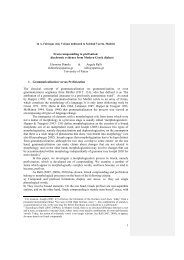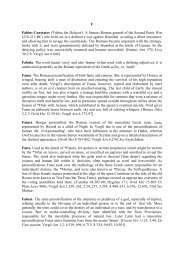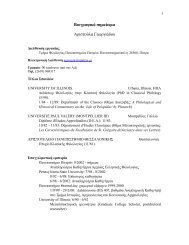Case mismatches in Greek: Evidence for the autonomy of morphology
Case mismatches in Greek: Evidence for the autonomy of morphology
Case mismatches in Greek: Evidence for the autonomy of morphology
You also want an ePaper? Increase the reach of your titles
YUMPU automatically turns print PDFs into web optimized ePapers that Google loves.
186 manuel espaol-echevarra and angela ralli<br />
language, e.g., Mohawk. It is fur<strong>the</strong>r predicted that <strong>the</strong> three features do not<br />
have to be equally visible to syntax. 8<br />
Let us proceed by exam<strong>in</strong><strong>in</strong>g rstly <strong>the</strong> notion <strong>of</strong> non-movement cha<strong>in</strong><br />
<strong>for</strong>mation, and <strong>the</strong> non-dist<strong>in</strong>ctiveness condition on <strong>the</strong> features <strong>in</strong>volved <strong>in</strong><br />
this sort <strong>of</strong> cha<strong>in</strong>s proposed <strong>in</strong> (1iv).<br />
2.1. Co<strong>in</strong>dexation and feature <strong>in</strong>terpretability<br />
In this section, we would like to propose that <strong>the</strong> Cha<strong>in</strong> Condition <strong>in</strong> (1) must<br />
<strong>in</strong>volve constituents that are nondist<strong>in</strong>ct <strong>in</strong> +Interpretable features. Thus,<br />
our claim is that <strong>the</strong> nondist<strong>in</strong>ctiveness <strong>of</strong> <strong>the</strong> features <strong>in</strong>volved <strong>in</strong> CLLDcha<strong>in</strong>s<br />
should be relativized accord<strong>in</strong>g to <strong>the</strong> +/;Interpretable dist<strong>in</strong>ction <strong>in</strong><br />
Chomsky (1995). On <strong>the</strong> basis <strong>of</strong> this dist<strong>in</strong>ction, <strong>Case</strong> is syntactically characterized<br />
as ;Interpretable, while Gender and Number are +Interpretable. 9<br />
A ;Interpretable feature, i.e., <strong>Case</strong>, is <strong>in</strong>visible to <strong>the</strong> C-I level, as opposed<br />
to <strong>the</strong> +Interpretable features <strong>of</strong> Gender and Number which belong to <strong>the</strong><br />
features visible to this level. This dist<strong>in</strong>ction between +Interpretable and<br />
;Interpretable features allows us to derive <strong>the</strong> contrast <strong>in</strong> grammaticality be-<br />
8<br />
As may be expected by such assumptions, <strong>the</strong> overt manifestation <strong>of</strong> <strong>Case</strong>s is not<br />
isomorphic with <strong>the</strong> set <strong>of</strong> functions that <strong>the</strong>se <strong>Case</strong>s may express. For <strong>in</strong>stance,<br />
more than one functions are expressed by Genitive case <strong>in</strong> <strong>Greek</strong>, e.g., <strong>in</strong>direct object,<br />
adnom<strong>in</strong>al relation, cf. footnote 5.<br />
9<br />
Notice that <strong>the</strong> +/;Interpretable opposition could also dist<strong>in</strong>guish dierent types <strong>of</strong><br />
cases. For <strong>in</strong>stance, structural cases, suchasAccusative or Nom<strong>in</strong>ative, are, <strong>in</strong> <strong>the</strong> general<br />
case, ;Interpretable, whereas <strong>in</strong>herent cases could be considered +Interpretable,<br />
s<strong>in</strong>ce <strong>the</strong>y are, by denition, closely related to -mark<strong>in</strong>g. However, even <strong>the</strong> most<br />
structural cases may sometimes be related to a semantic <strong>in</strong>terpretation, and thus behave<br />
as +Interpretable features, as <strong>the</strong> follow<strong>in</strong>g Lat<strong>in</strong> example seems to <strong>in</strong>dicate,<br />
cf. Blake (1994, 32):<br />
(i) Vado Romam<br />
go-1sg Rome-acc (dest<strong>in</strong>ation)<br />
`I go to Rome'<br />
The occasional behaviour <strong>of</strong> Accusative asan<strong>in</strong>herent <strong>Case</strong> can be expla<strong>in</strong>ed by assum<strong>in</strong>g<br />
that a constituent may be associated to both a structural and an <strong>in</strong>herent <strong>Case</strong><br />
<strong>in</strong> certa<strong>in</strong> contexts, as argued <strong>in</strong> Torrego (1998) (but see Babby (1980), Yip Mal<strong>in</strong>g<br />
Jackendo (1987), and McCreight (1988) <strong>for</strong> <strong>the</strong> opposite view). In section 2.3.1,<br />
we propose that <strong>Case</strong>, both <strong>in</strong> its structural and <strong>in</strong>herent manifestations, is never a<br />
+Interpretable feature. The fact that <strong>in</strong>herent C ase may show certa<strong>in</strong> properties <strong>of</strong><br />
+Interpretable features can be derived from its close relation to -mark<strong>in</strong>g.<br />
Acta L<strong>in</strong>guistica Hungarica 47, 2000










